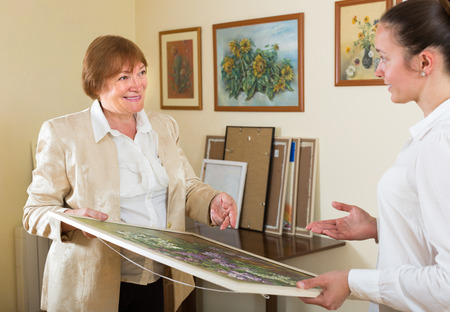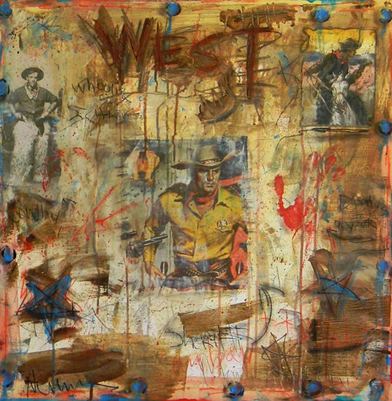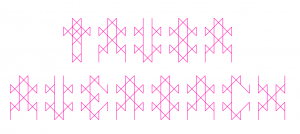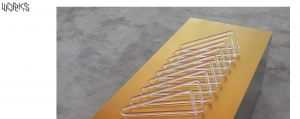
Marketing people love to talk about brands. It’s easy to see that branding is important to large corporations, but did you know that you can implement branding principles that will help you sell more of your art? So what is branding? Entrepeneur.com defines branding as:
Simply put, your brand is your promise to your customer. It tells them what they can expect from your products and services, and it differentiates your offering from that of your competitors. Your brand is derived from who you are, who you want to be and who people perceive you to be. (www.entrepreneur.com)
People often confuse the word “brand” with the word “logo”. From the definition above, you can see that a brand is far more than just a logo. In fact, a logo is just a small tool that helps you convey your brand to your customers.
So how do you create your brand, and how do you project that brand to your clientele? Let’s look at five important steps in the branding process.
Get to Know Your Customers and Build Meaningful Relationships with Them
If branding is the process of conveying your promise to your customers, it’s a good idea to know who your customers are and what they need. The better you understand your customers, the better you will be able to deliver on your promise to them.

Knowing your customers will also help you recognize future potential buyers who share similar traits. It’s a mistake to think you can sell your art to anyone and everyone. The truth is that within the broader market, there is a niche of people who are going to be interested in your work and who are going to be able to purchase it. The more you know about this niche, the better you will be able to target it.
Does your artwork appeal to buyers of a certain age? Do your buyers tend to come from a certain professional background? Do your buyers share common interests or hobbies?
So how do you get to know all of this information? By building relationships with your customers. If you are selling directly to your clientele at art shows or open studio events, I would encourage you to work toward building lasting relationships with your buyers, not just selling to them once. Building relationships takes time and care, but if you can demonstrate genuine interest in your clients, you will be well on your way. If you haven’t read Dale Carnegie’s book, How to Win Friends and Influence People (or if it’s been a while) I highly recommend it. The book is a classic, but the principles are just as true today as they were when the book was written over 60 years ago.
If you are showing your work through galleries, it can be more difficult to get to know your clients since the gallery sits between you and the customer. Show receptions are a great opportunity to get to know your customers, but you could also encourage the galleries you work with to set up private lunches or dinners with clients (with the gallery owner or director present, of course).
You can also survey your past clients to get a better sense of who they are and what they like about your work. TechRepublic.com wrote a great step-by-step guide for using Google forms to create a survey, which you could send out to your mailing list.
Know Yourself and Your Art
Of course, knowing your customer is only part of the battle. You also need to know what you have to offer that is unique. The art market is a very competitive place and there are many, many artists out there vying for attention. How can you possibly stand out in such a crowded market place?
I would suggest that it’s important to think of your motivation instead of your product (your artwork). If you are a painter of impressionistic landscapes, you are one of tens of thousands of impressionistic landscape painters. Let’s face it, it’s going to be hard to find something unique in the work that sets it apart from the competition. What is unique, however, is the path that brought you to create your art. The particular combination of your life experiences, your passion and your approach to your art make you unique. In other words, the branding is about you more than it is about the art. The better you understand yourself and your passion and where your artwork is coming from, the better you are going to be able to build a successful brand as an artist.
Be Consistent
I’ve written frequently on the importance of consistency. Creating consistent work has its own rewards, but it also plays a huge roll in your brand. If you know what your interests and motivation are, and you strive to create work that is in keeping with your passion, consistency should come naturally. Some artists have to work through a number of different styles and subjects to figure out where their passion lies. The end goal should be to find a style that can sustain your creative energy over the long run.
Certainly your work will evolve over time, and your passion may lead you in different directions, but those changes should come over the course of years or even decades. You shouldn’t be completely reinventing yourself every couple of months.
Think of the great artists in history – Picasso, Monet, Georgia O’Keeffe, Rodin, Pollock, etc. – each created a distinctive look and stuck to it. As I said, these artists’ styles evolved over time, but not so radically that you couldn’t recognize the underpinnings of the artist’s voice.
Design
Once you have begun to discover your voice and your motivations, strive to create design that matches your brand. Your logo, website, business cards, brochures, emails and other printed materials should all consistently convey the message about who you are. An experienced graphic designer will be able to help you capture your brand for your materials.
Examples
A couple of examples will help illustrate how design can reflect an artist’s brand:
Dave Newman – a Xanadu Gallery represented artist has a background in graphics and has done a great job of creating a visual language on his website that fits his work perfectly. You can visit Dave’s site at www.davenewmanstudio.com/ to see what I mean.
Above: Dave Newman’s collage “Blood is on Your Hands” and the banner from his website with links.
Conceptual artist Tauba Auerbach’s website looks like abstract squiggles and lines, until you realize the artist has created a quasi-hieroglyphic typeface that matches artist’s work. Experience the website.
Above: Home page for Tauba Auerbach’s website and the sculptural piece “Helix”
Your site doesn’t have to be quite as custom or radical as these sites, but it should be in keeping with your brand.
Get Out There!
Your brand can’t exist in a vacuum. While you can put a lot of thought and effort into creating a brand, until you put yourself and your work out in front of collectors, it’s all theory. Those who experience your work may be able to tell you more about your work than you can. Ask people, “What do you find to be unique about my work?” and “What first drew you to my art?”
Showing your work in art shows and festivals or open studios can be a great way to get your feet wet in the market and to build your brand awareness. Showing in galleries will help you further solidify your brand.
Exercise
Want a quick jump start to developing branding around yourself and your work? Answer the questions below – I would encourage you to write out your responses. Your answers will be a good start towards building a stronger brand.
- How would you respond to someone who asks you, “What kind of art do you do?”
- Once you’ve answered that question, how would you answer the follow-up question “Why do you do that kind of art?”
- What words do your clients commonly use to describe your work?
What is your Brand?
Have you worked to develop your brand? How has it helped your art business? What do you plan to do to further develop your brand? Do you know of artists who have done a good job of creating brands (share their website address)? Please share your thoughts and experience in the comments section below.




I plan this year to start exploring new avenues of making art; specifically fabric art. So my branding may include textures in the background of things like business cards. My artworks generally focus on animals, birds and insects in an abstract setting. I love animals but I like taking them out of their normal settings so you can see them differently.
I am a figurative artist. My art is more realistic than impressionistic. I do many subjects ; portraits, landscape , still life, etc. But I love to do abstracts paintings sometimes. I think it’s help me to get out of my comfort zone. I question myself if it is better to do abstracts just for myself and not show those paintings on my website to show consistency. I put some on my website. But I have more abstracts paintings that I like very much and I think there have a good potential of selling. Recently I had the idea to sell them in limited prints. What should I do?
At this stage in my development, I can definitely relate to the comment “Some artists have to work through a number of different styles and subjects to figure out where their passion lies”. I see 2021 being a year where I hone in on elements that inspire me the most and I look forward to a body of work that demonstrates consistency, yet is a continuation of my explorations. Thanks for the great article!
Many years ago now, when I was just out of college, I signed on with an agent. I was very uncertain of the road I was on, but the agency liked me because I worked so hard, and was taking me on as a kind of trainee. In a conversation with one of the reps, he said: “….If you develop a ‘look’, it might catch on and you’ll be well known, or you can paint in a realistic style and you’ll work all the time..”. I chose the latter, and worked steadily over the next 25 years. I tried many things as a student, but at some point, over a long time, all my work became “me”. I paint many different subjects, and do varied works for different galleries, but for anyone who sees a portrait of a “royal rabbit”, or a “waterfall” of mine in different galleries, they’ll recognize them both as mine.
Probably the most important statement I ever heard was: “you paint like you drive a car”. Yes, for every up-and-coming artist, try everything and keep working. Sooner or later you’ll find your real self. You’ll know it, and prople who know art will see it.
To me Branding is the look and feel of whatever you are marketing. (Logo, Web Site, Letterhead, Business Card etc.)
PR covers the getting to know your customers and building relationships that will last.
I have been creating art for many years now and looking back I can see a trail that has followed me thru it all. Although my style has changed over the years there are certain things that have stayed the same. Don’t know that I would consider that branding. (Maybe)
I am currently working on a series of acid
related painting that reflect a time in my life that was all about love, peace, flowers and good friends (better known as the 60’s) My how times have changed.
So anyway, branding is important for businesses to keep there name out there and hopefully be easy to recognized. Like a big yellow capital M. Makes me hungry just thinking about it.
Thank you Jason.
This article is very interesting and helpful.
I am what I consider an Impressionistic Landscape artist. But those landscapes could include barns, buildings, water, a beach , flowers, or animals at times as well.
Basically though, it is about nature. I have drawn and painted just about all my life.
It has been my passion for others to see and feel nature as a gift to take care of and to treasure. Especially for viewers of my work to feel the serenity and peace of nature. How to make that as a clear brand puzzles me.
I have never really thought much about a brand until this past year. Now to figure it all out.
Hi, Sandy,
Like you, my work has mostly been about nature. I like the more dynamic aspects but the main idea is that nature is relaxing, healing after a day dealing with people, cars, paperwork. How do we turn that into a distinctive brand since almost all art about nature is by people who feel the same as we do?
Now to figure it all out.
I used to paint whatever captivated me and I was all over the map. I discovered that the idea of birds in people spaces really connected with many of my friends and relatives. When I encountered the idea of branding, from you I think, I finally was able to articulate my brand. Here’s a clip from my About The Artist page that answers those first two questions.
“Jan Dale’s bird paintings are an unusual blend of nature and stillife. A storyteller at heart, she developed her style on the premise that birds are as curious about humans as we are about them, often availing themselves of objects that humans leave behind. Her fascination with birds and her love of antiques combine to tell stories of the people and creatures she loves.”
I know it needs work but it’s sure better than the hodge-podge I had going on just four years ago…and I’m beginning to see more sales as a result. Now to get the name of my website and email in line. LOL!
So thank you not only for those older articles on this topic, but also for this one. Very affirming!
This is such a helpful article thank you Jason. I have never felt confident about using my story within my artwork as it may be seen as not very uplifting and negative but it was what it was.
I’ve just always known that due to a disruptive and unsettling childhood I came to enjoy painting birds – perhaps it was something about their ability to fly away?!
I am not sure how to translate my story specifically to collectors as I’m really just a bird artist and rely on bird lovers in general to buy and enjoy my art but it is hard to stand out and I definitely always knew this was why I painted birds.
It can take a while to figure out your brand. Yes after a few tries I’ve settled on this:
I’m a textural impressionist artist who’s art is a reflection of “Home”. For me this entails a few homes. Yet it gives you the comfortable feeling you have when you are home.
It happens I finally asked myself. What is the connect in all my art. It dawned on me. Home. Usually there is a story behind a piece too.
in basic the establishment of a brand/look/feel that is identifiable is a good approach to set yourself apart. It then allows you to identify and specifically locate the clients who like that theme/style form. It will happen gradually if you can stick it out or by purposefull focus a bit quicker. For myself i sell almost exclusively to high level business owners, museums and govts that relate to the theme of my work [canadian history and landsapes done as series] and can afford the values asked. To serve the private collectors i also do plien aire landscapes to meet the size and budget range as well as ltd editions. This has developed to a global business over 50 years. To start find your style and identify your collector base.
Recently I have begun using the term “visual voice” when describing my brand or style. Over the years and decades art terms related to style have evolved to a point of being almost meaningless. Mention style when explains ones and an image or definition pops into a listener’s mind which may or may not fit the artist’s work. When I say my visual voice is, they tend to listen more closely.
I am figurative sculptor my style or whatever is myself that is at least what observers of my sculptures have said that they could see the sensitivety and delicateness. I do not see it i just try to replicate the picture in my mind and stay true to what i believe the truth is and how i perceive it
Another great article. This sentence is true.
Those who experience your work may be able to tell you more about your work than you can.
People will share with you what draws them to your art. While it can be hard to meet with the public, it is important to engage because they will give you the necessary information you need as an artist. It doesn’t happen immediately. But over time an artist can gain insight about how their work affects people.
Thanks so much.
This is a good article pointing to aspects of the art business that, we as artists, need to relate and be aware of. However, coming from another culture (Latin America-Argentine), I can see that this kind of view/approach indicated in the article pertains to a highly individualist and competitive society. In emotional, community oriented societies, where critical thinking and culture is highly regarded, art is part of a continuum flow of cultural interaction where the kind of emphasis indicated in this article are not constantly in the face of the artist.
hi Jason……enjoyed this article. its been tough for me ,I enjoy doing so many different types art. I am 84 years old today and I I’m still searching for my brand.i have worked in so many fields, painting 3 d, sport art, greeting cards. it”s just hard for me to settle on one subject and style, very good article……THANK YOU BEN DE SOTO……ALSO I A’M AN OLD FREIND OF DAVE AND DONNA NEWMAM WE GO WAY BACK. THANKS AGAIN …..BEN
Hi Jason, great article. Besides working of art ideas I also create digital portfolios a little like you showed us on Google slides. Two of my clients asked me about what sort of a niche should they focus on, as they can’t decide what they want to focus on and what are collectors looking for. I would like your opinion on that so I can forward this advice to them. Thank you in advance, Bob
Earlier in my life I was all over the place but in my second career, I have branded myself and my style. People see my art and they immediately know who painted it. I just got gallery representation and it was because my art is consistent in style,. I tend to get bored so I’ve veered into different subject matter but the style remains to same..